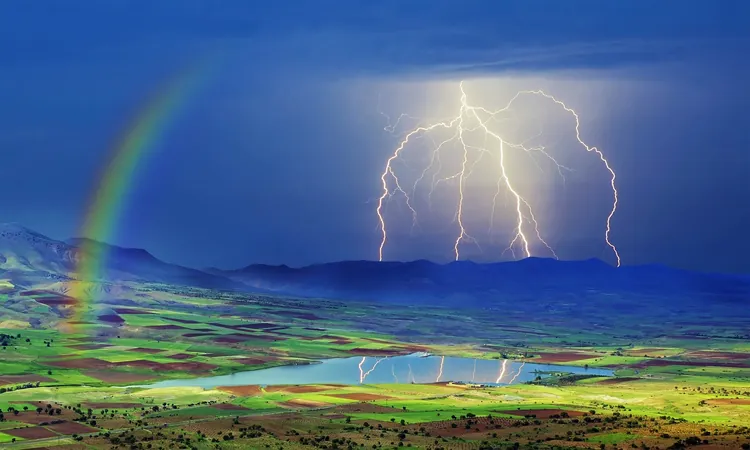
The Unbelievable Truth Behind One Million Years of Rain that Led to the Dinosaur Reign!
2024-11-15
Author: Jia
Imagine a time when our planet was an unrecognizable landscape, where all landmasses were fused into a single supercontinent known as Pangea. This pivotal moment occurred roughly 233 million years ago, during a striking climatic event known as the Carnian Pluvial Episode (CPE), which lasted for an astonishing one million years of relentless rain.
The Carnian Pluvial Episode Unveiled
During the Late Triassic period, Pangea was encircled by the vast Panthalassa Ocean, and the interior was predominantly dry. However, in the 1970s, researchers stumbled upon a layer of dark gray rock in Austria's Northern Limestone Alps that indicated fluctuations between wet and dry periods, a clue suggesting a significant environmental shift.
The primary driver of the CPE was massive volcanic eruptions in what is now the Wrangellia Province, covering parts of Alaska and British Columbia. These eruptions released immense quantities of carbon dioxide into the atmosphere, leading to severe global warming.
Dr. Dal Corso remarks, "The eruptions peaked during the Carnian and were earth-shattering in scale, creating spikes in greenhouse gases that drastically affected the climate.”
Extinction and Rebirth
The influx of carbon dioxide caused global temperatures to soar by approximately 5 to 7 degrees Fahrenheit, unleashing a wave of climate chaos that resulted in widespread biodiversity loss. Numerous species were unable to adapt to the rapid environmental transformations, precipitating a mass extinction event. However, this extinction opened new ecological niches that allowed other species to thrive, giving rise to a new era of biodiversity.
Professor Benton explains the aftermath of this chaos: “Dinosaurs had been around for around 20 million years prior but were relatively insignificant until the CPE. The ensuing dry conditions after the humid episode allowed dinosaurs to rise to prominence.”
The Rise of Dinosaurs and New Ecosystems
As climates shifted back to arid conditions, dinosaurs flourished alongside the first turtles, crocodiles, lizards, and even early mammals. The expansion of conifer forests provided new habitats, further diversifying life forms. The oceans also transformed during this period, witnessing the emergence of modern coral reefs and various planktonic life, underpinning significant shifts in marine ecosystems.
A Sixth Mass Extinction?
Traditionally, scientists acknowledged five key mass extinction events throughout Earth’s history, but recent findings suggest the Carnian Pluvial Episode qualifies as a sixth. According to Dr. Dal Corso, “This extinction event was crucial in reshaping life both on land and in the oceans, laying the groundwork for modern ecosystems.”
Lessons for Today
The ancient Carnian Pluvial Episode underscores the profound effects that volcanic activity and climate change can have on life on Earth. With current human activities contributing to rising greenhouse gas levels, the lessons from the CPE are more relevant than ever.
Dr. Dal Corso emphasized, “Understanding historical climate shifts teaches us about our planet’s resilience and adaptability,” while Professor Benton echoed, “Each scientific discovery adds a layer to our comprehension of Earth’s dynamic history.”
As we grapple with modern environmental challenges, the resurgence following catastrophic events like the CPE presents a cautionary yet hopeful message about life’s inherent ability to adapt.
Looking back at these transformative moments, it's imperative we comprehend how Earth's ecosystems respond to rapid changes, both natural and human-induced, shaping our future and the legacy we leave behind.
Stay informed about our planet’s epic story by subscribing for more fascinating insights from Earth’s prehistoric past!

 Brasil (PT)
Brasil (PT)
 Canada (EN)
Canada (EN)
 Chile (ES)
Chile (ES)
 España (ES)
España (ES)
 France (FR)
France (FR)
 Hong Kong (EN)
Hong Kong (EN)
 Italia (IT)
Italia (IT)
 日本 (JA)
日本 (JA)
 Magyarország (HU)
Magyarország (HU)
 Norge (NO)
Norge (NO)
 Polska (PL)
Polska (PL)
 Schweiz (DE)
Schweiz (DE)
 Singapore (EN)
Singapore (EN)
 Sverige (SV)
Sverige (SV)
 Suomi (FI)
Suomi (FI)
 Türkiye (TR)
Türkiye (TR)